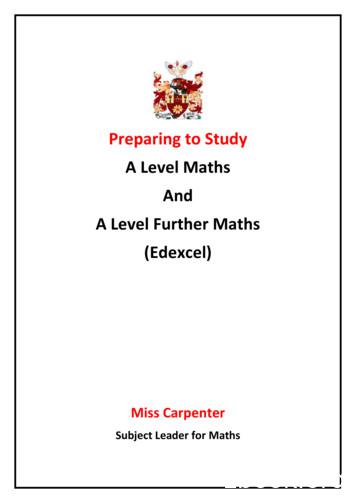A LEVEL MATHS - MECHANICS REVISION NOTES
A LEVEL MATHS - MECHANICS REVISION NOTESKINEMATICS Distance - a scalar quantity with no direction 160 m Displacement - a vector quantity – measuredfrom the starting position 40 m (East of starting point) Position - a vector quantity – distance from a fixed originAVERAGE SPEED 𝑇𝑜𝑡𝑎𝑙 𝐷𝑖𝑠𝑡𝑎𝑛𝑐𝑒EastAVERAGE VELOCITY 𝑇𝑜𝑡𝑎𝑙 ��𝑒𝑛𝑡𝑇𝑖𝑚𝑒 𝑡𝑎𝑘𝑒𝑛USING Position-Time and Velocity-Time GRAPHSstationaryVelocity – time graphMoving backtowards thestarting pointVelocity ms-1Position- time graphGradient velocityTime (s)VELOCITY TIME GRAPHGradient accelerationCONSTANT ACCELERATION(Straight Line)DISPLACEMENT – AREAUNDER THE GRAPHVELOCITY 0Moving in the oppositedirection – back towards thestarting positionVelocity ms-111www.mathsbox.org.uk
EQUATIONS FOR CONSTANT ACCELERATION s: displacement (m) u : initial velocity (ms-1)v : final velocity (ms-1)a : acceleration (ms-2)t time (s)v2 u2 2asv u ats ½(u v)t s ut ½at2s vt - ½at2Acceleration due to gravity is 9.8 ms-2 (unless given in the question)Negative Acceleration means retardation/decelerationYou may need to show how the equations can be derived from the graphA car starts from rest and reaches a speed of15 ms-1 after travelling 25m with constantacceleration. Assuming the acceleration remainsconstant, how much further will the car travelthe next 4 seconds?u 12 ms-1a -9.8 ms-2At maximum height v 0v2 u2 2as0 144 - 2 9.8 ss 7.35 mu 0 ms-1v 15 ms-1s 25 mv2 u2 2as 152 2a 25a 4.5 ms-2u 15 ms-1t 4a 4.5A ball is thrown vertically upwards with a speedof 12 ms-1 from a height of 1.5 m. Calculate themaximum height reached by the ball.Maximum height 1.5 7.35 8.85 ms ut ½ at2s 15 4 ½ 4.5 16 96 m2FORCES and ASSUMPTIONSKEY FORCESW : weight (mg mass 9.8)R : reaction (normal reaction – at right angles to the point of contact)F : friction (acts in a direction opposite to that in which the object is moving or is on the pointof moving)T : TensionASSUMPTIONS Objects are modelled as masses concentrated at a single point so no rotational forces. Strings are inextensible (inelastic) so any stretch can be disregarded Strings and rods are light (no mass) so weight can be disregarded Pulleys are smooth so no frictional force at the pully needs to be considered.2www.mathsbox.org.uk
RESOLVING FORCESCalculate the resultant force acting on theparticle giving you answer in the form ai bjWorking in i (horizontal)Ri 35cos45 - 12 12.7 NWorking in j (vertical)Rj 35sin45 - 10 14.7 NR 12.7 i 14.7 jThe forces shown in the diagram act onparticle A of mass 0.8 kg. Calculate themagnitude of the acceleration of the particleResultant force 12.7i 14.7jForce mass acceleration0.8a 12.7i 14.7ja 15.875i 18.375j a 15.8752 18.3752 a 24.3 ms-2 (3 s.f.)If the system is in Equilibrium, then resultant force 0Take care with objects on slope – always draw a diagram showing all the forcesA box of mass 5 kg rests on a slope inclined at an angle of 30 to the horizontalCalculate the normal reaction and the frictionResolving perpendicular to the slope R 5g cos 30 42.4 N (3 s.f)Resolving parallel to the slope F 5g sin 30 24.5 N(3 s.f)COEFFICIENT OF FRICTIONThe maximum or limiting value of friction Fmax is given byFmax 𝝁𝑹 R is the normal reaction and 𝜇 is the coefficient of frictionIf a force is acting on the object but the object remains at rest then F 𝜇𝑅When the object is moving the frictional force is constant (Fmax)For questions looking at the minimum and maximum force needed to move a block on a rough slopelook at the magnitude of force PWhen the block is on the verge of sliding down the slopeFriction is ‘acting up the slope’When the block is on the verge of sliding up the slopeFriction is ‘acting down the slope’3www.mathsbox.org.uk
3NEWTONS LAWS1st LAW : Every object remains at rest or moves with constant velocity unless an external forceis appliedThe system is in EQUILIBRIUMT FR W2nd LAW : The resultant force acting on an object is equal to the acceleration of that body times itsmass.F ma3rd LAW : If an object A exerts a force on object B, then object B must exert a force of equalmagnitude and opposite direction back on object A.Calculate the acceleration of the objectResultant force 12000 – 6000 6000 N6000 8000aa 0.75 ms-2A man of mass 80 kg stands in a liftCalculate the normal reaction of the lift floor on the man ifa)The lift is moving downwards with constant velocityConstant velocity so R WR 80g N 784 Nb)R2 ms-2The lift is moving upwards with acceleration of 2 ms-2Upwards movement so R W R – 80g 80 2R 944 NWTwo masses are connected by a light string passing over a smooth pulley as shown below.Calculate the acceleration of the 4 kg block when released from rest.Pulley5 kg Block : 5g – T 5a4kg Block : T – 2 4aSolving simultaneously 5g – 2 9aa 5.22 ms-2Forces F1 2i j, F2 -3i 4j and F3 4i – 6j act on a particle with mass 10 kg. Find the magnitude ofacceleration of the particleResultant force F1 F2 F3 (2i j) (-3i 4j) (4i – 6j) 3i – jF ma3i – j 10a a 0.3i -0.1j a 0.32 ( 0.1)2 a 0.316 ms-24www.mathsbox.org.uk
4VARIABLE ACCELERATION (r : position)r f(t)𝑑𝑣𝑑𝑡𝑑𝑟𝑑𝑡 r 𝑣 𝑑𝑡INTEGRATING - Don’t forget toinclude ca DIFFERENTIATINGv Displacement r (m)Velocity v (ms-1)𝑑2𝑟Acceleration a (ms-2)𝑑𝑡 2v 𝑎 𝑑𝑡a f(t)Remember Area under a velocity time graph displacement Gradient at a point on position/time graph velocity Gradient at a point on velocity/time graph accelerationThe acceleration of a particle (in ms-2) at time t seconds is given by a 12 – 2t.The particle has an initial velocity of 3 ms-1 when it starts at the origin.a) Find the velocity of the particle after t secondsv 12 2𝑡 𝑑𝑡v 12t – t2 ct 0 v 3b) Find the position of the particle after t secondsr 12𝑡 𝑡 2 3 𝑑𝑡 6𝑡 2 c 3v 12t – t2 3r 0𝑡33t 0 3𝑡 𝑐r 6𝑡 2 𝑡33 3𝑡A train moves between 2 stations, stopping at both of them1Its speed at t seconds is modelled by V t(1200 – t) (ms-1)5000Find the distance between the 2 stationsAt the stations v 01200Distance 01t(120050001t(12005000– t) 0– t)𝑑𝑡 t 0 t 12001[600𝑡 25000 𝑡33 𝑐] 57600 m 57.6 km5www.mathsbox.org.uk
5PROJECTILESInitial Velocity : u Ucosθ i Usinθ jU ms-1θAcceleration : a -g jVelocity after t seconds:v Ucosθ i (Usinθ – gt) jParticle moving in a horizontal direction (reaches maximum height)when j component 0 Usinθ – gt 0Displacement after t seconds (r)𝑔R Utcosθ i (Utsinθ j – 2 t2)jIf launched from the ground the particle will return to the ground𝑔when rj 0 Utsinθ – t2 02Solve the equation to find the values of t. Substitute ‘t’ into the icomponent of r to calculate the rangeA shot putter releases a shot at a height of 2.5m, with speed 10 ms-1 at an angle of 50 to thehorizontal. Calculate the horizontal distance from the thrower to where the shot lands.u 10cos50 i 10sin50 ja -9.8 ms-2js 10tcos50 i (10tsin50 – 4.9t2) jStarting height 2.5 m so hits the ground when sj -2.510tsin50 j – 4.9t2 -2.5(t -0.277) or t 1.84Horizontal distance travelled when t 1.84 10 1.84 cos 50 11.8 m (3 s.f.)6MOMENTSThe moment of a force about point A ismoment Force d (Nm)(anticlockwise)The moment of a force about point B ismoment Force dsin θ (Nm)(clockwise)d is the perpendicular distance ofthe line of action of the force from AThe resultant moment is the difference between the sum of the clockwise moments and sum of theanticlockwise moments (in the direction of the larger sum)6www.mathsbox.org.uk
Uniform Lamina - (usually rectangular) – has same density throughout – Centre of mass throughwhich the objects weight acts is the centre of the rectangleUniform Rod centre of mass is at the midpoint of the rodEquilibriumIf an object is in equilibrium the resultant force is zero and the total moment of all the forces is zeroTo solve problems- Draw a diagram showing all the forces- By taking moments about a point you can ignore the forces acting at that point (d 0)- Resolve the forces horizontally, verticallyA uniform bridge across a steam is 5m long and has a mass of 100 kg. It is supported at the ends A and B.A child of mass 45 kg is standing on the bridge at point C. Given that the magnitude of the force exertedby the support at A is three-quarters of the magnitude of the force exerted by the support at B calculatethe magnitude of the force exerted at support A and the distance ACResolving vertically : 1.75R 145gR 82.9g N (3 s.f.)Force at A 0.75R 62.1g NLet AC d mTaking moments about A: (2.5 100) (45 d) 5 82.9250 45d 414.5d 3.66 mNOT ON ALL EXAM BOARDSA uniform ladder of length 3 m, and mass 20 kg, leans against a smooth, vertical wall, so that the angle betweenthe horizontal ground and the ladder is 60 . Find the magnitude of the friction and the normal reaction forces thatact on the ladder if it is in equilibrium7www.mathsbox.org.uk
4 www.mathsbox.org.uk 3 NEWTONS LAWS 1st LAW : Every object remains at rest or moves with constant velocity unless an external force is applied The system is in EQUILIBRIUM T F R W 2nd LAW : The resultant force acting on an object is equal to the acceleration of that body times its mass. F ma 3rd LAW : If an object A exerts a force on object B, then object B must exert a force of equalFile Size: 550KB
SAU PhD Maths Questions Papers Contents: SAU PhD Maths Que. Paper-2014 SAU PhD Maths Que. Paper-2015 SAU PhD Maths Que. Paper-2016 SAU PhD Maths Que. Paper-2017 SAU PhD Maths Que. Paper-2018 SAU PhD Maths
Maths ‘After Maths’– KS3 students Miss Cahill Y16 3-4pm Maths After School Mentoring Club - Year 8.9.10 (29 Sept 15 to 22 Oct 15 inclusive) Maths Department LRC 3-3.45pm Maths Revision – Year 11 R-Band GCSE Maths
A Level Maths . And . A Level Further Maths (Edexcel) Miss Carpenter . Subject Leader for Maths. Introduction to those considering A Level Mathematics/ Further Mathematics next year Due to the coronavirus pandemic it has been a while since you have studied some Maths. So
maths, statistics and mechanics. There will be 3 externally set exams at the end of your 2nd year: 2 in core and 1 in Applied. At the end of your first year you will take an internally marked exam to assess your progress. . TL Maths videos for further maths, this is not as complete as the A
Prepared for District 5 Toastmasters By Mark Kramer, DTM Original Version July 2007 1st Revision June 2008 2nd Revision November 2008 3rd Revision June 2009 4th Revision May 2010 5th Revision May 2011 6th Revision May 2012 7th Revision May 2013 8th Revision May 2014 9th Revision Nov
PRIMARY MATHS SERIES SCHEME OF WORK – YEAR 6 This scheme of work is taken from the Maths — No Problem! Primary Maths Series, which is fully aligned with the 2014 English national curriculum for maths. It outlines the content and topic order of the series and indicates the level of depth needed to teach maths for mastery.
Year 7 & 8 Numeracy Workbook. Week Topic AFL 1 Addition 2 Subtraction 3 Mental Maths 4 Multiplication 5 Division 6 Mental Maths 7 BIDMAS 8 Percentages 9 Mental Maths 10 Simplifying Fractions 11 Adding Fractions 12 Mental Maths 13 Fractions-Decimals-Percentages 14 Ratio 15 Mental Maths 16 Collecting Like terms 17 Substitution 18 Vocabulary and Directed Numbers 19 Word Based Puzzle. Week 1 Maths .
maths indu art indu tue eng indu hindi indu maths indu music indu wed eng indu hindi indu maths indu art indu thu eng indu hindi indu maths indu ls indu fri eng indu hindi indu comp rupam maths indu sat eng indu hindi indu maths indu music indu d.a.v public school, sasaram online class time-table d.a.v public school, sasaram online class time .























